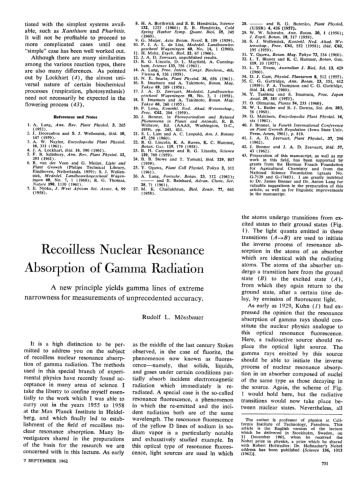Recoilless Nuclear Resonance Absorption of Gamma Radiation

It is a high distinction to be permitted to address you on the subject of recoilless nuclear resonance absorption of gamma radiation. The methods used in this special branch of experimental physics have recently found acceptance in many areas of science. I take the liberty to confine myself essentially to the work which I was able to carry out in the years 1955 to 1958 at the Max Planck Institute in Heidelberg, and which finally led to establishment of the field of recoilless nuclear resonance absorption. Many investigators shared in the preparations of the basis for the research we are concerned with in this lecture. As early as the middle of the last century Stokes observed, in the case of fluorite, the phenomenon now known as fluorescence - namely, that solids, liquids, and gases under certain conditions partially absorb incident electromagnetic radiation which immediately is reradiated. A special case is the so-called resonance fluorescence, a phenomenon in which the re-emitted and the incident radiation both are of the same wavelength. The resonance fluorescence of the yellow D lines of sodium in sodium vapour is a particularly notable and exhaustively studied example. In this optical type of resonance fluorescence, light sources are used in which the atoms undergo transitions from excited states to their ground states (Fig. 1). The light quanta emitted in these transitions (A-+B) are used to initiate the inverse process of resonance absorption in the atoms of an absorber which are identical with the radiating atoms. The atoms of the absorber undergo a transition here from the ground state (B) to the excited state (A), from which they again return to the ground state, after a certain time delay, by emission of fluorescent light.